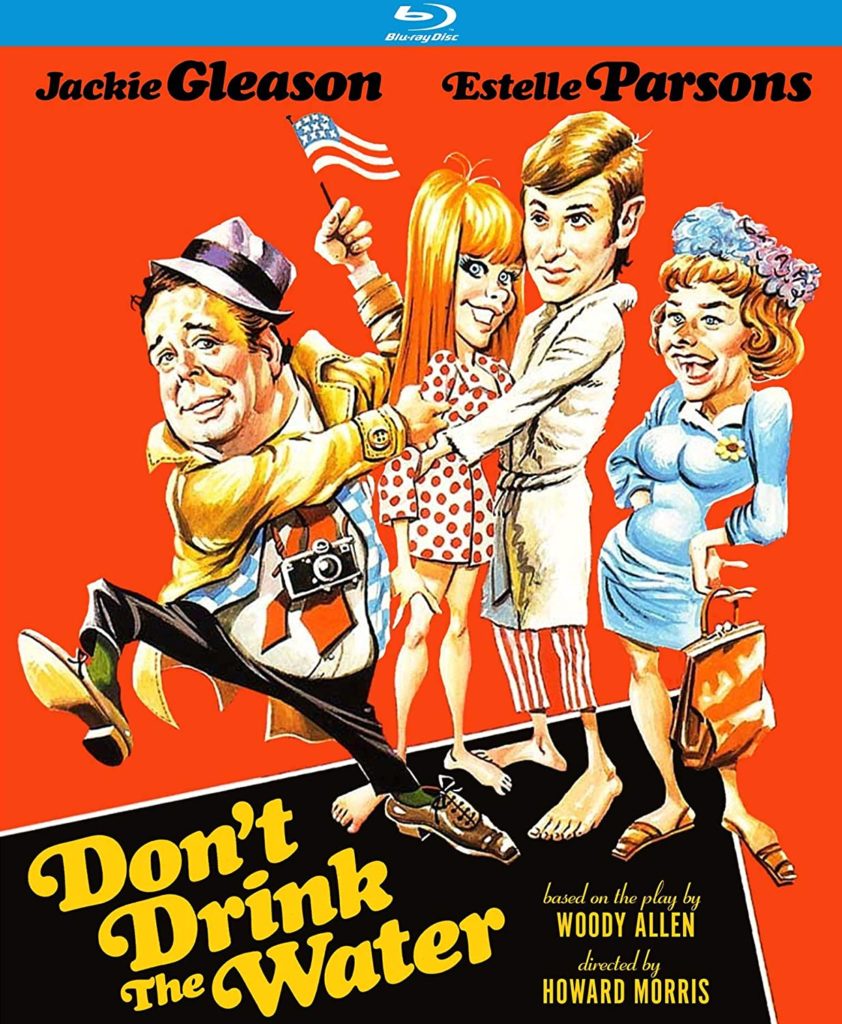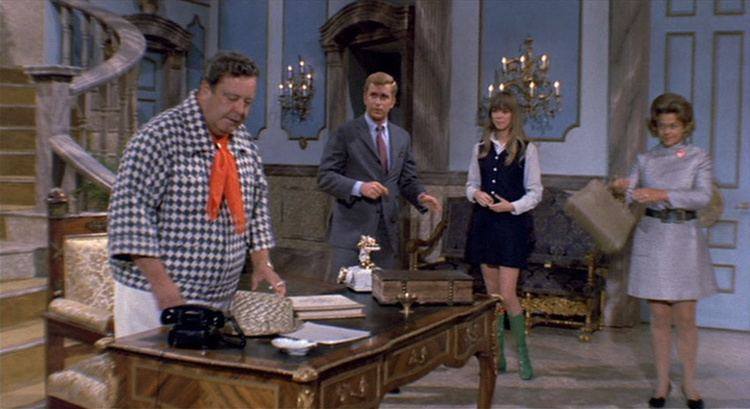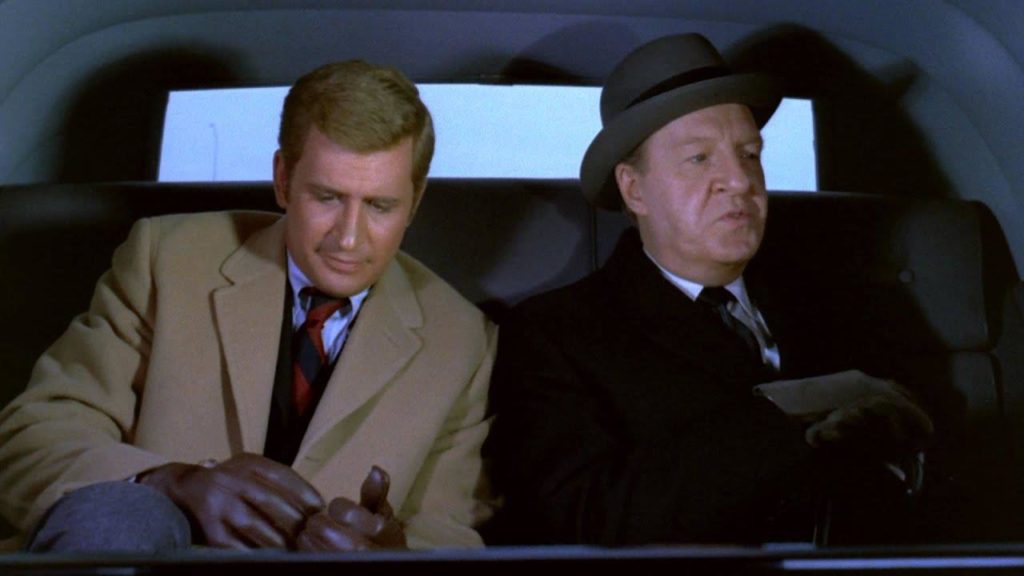Shelter-In-Place, 60s Farce Style
DIRECTED BY: HOWARD MORRIS/1969
STREET DATE: APRIL 28, 2020/KINO LORBER STUDIO CLASSICS

The opening montage informs less about the plot than it does the pace and attitude, which is free-wheeling, vaguely lurid, and happily shrill in that way that so many late 60s comedies are. (See: What’s New Pussycat? [1965]; The Russians Are Coming, the Russians Are Coming [1966]; Skidoo [1968], etc.) You could chalk it up to the then-semi-recent demise of the studio system, like daddy left home, took all the rules with him, and let the kids have the run of the place, and now the fun is nailed to the corners of the frame in bright colors, gaudy sets, and doused in a double spray of more-than-innuendo and never-less-than-uncorked rage. Packaged in montage-y set pieces and pumped out quickly for the non-discerning, just-get-out-of-the-house crowd, it’s ostensibly a family film, but check out that G rating plastered onscreen just before the snap-zoom to Joan Delaney’s flat-n-mod belly button – it’s a mixed message in a time when the movies knew what they didn’t want to be anymore, knew what they eventually wanted to be, but were self-consciously stuck in that awkward stage of gangly arms, binary arguments, and adult language that just doesn’t always land on the right syllable.
Based on the successful Woody Allen play of a couple years prior, but having little of his eventual singular voice – he had nothing to do with the adaptation, busy as he was with his then-current play, Play It Again, Sam, and his first true directed-by credit, Take the Money and Run – it seems like the kind of forgotten filler doomed to get panned with faint praise, and yet with all the proper context in play, one can settle in and enjoy the headlong free-fall into broad-as-the-Catskills comedy. Jackie Gleason is Walter Hollander, an American caterer who’s taking his wife (Estelle Parsons) and daughter (Delaney) to Europe when the plane gets hijacked to “Vulgaria”, somewhere behind the Iron Curtain. They lurch into the American embassy, where the bulk of the film they’re kept hostage in an escalating death match between boredom and demise by staged riots outside the gates, and we’re sequestered with them in a kind of commie sit-com of manners.

There’s a loose through line of political commentary befitting the times, but it’s the interplay among the family and their keepers (mainly ambassador’s son, Alex, played with square aplomb by Ted Bessell) that is the engine of the humor. And that humor is a pop-culture anthropologist’s dream, replete as it is with the gamut: husband-wife “to the moon!”-type shouting matches, zany incompetence among supposed men of authority, and, to be respectably trope-complete, characters in drag. It’s the kind of humor that has its roots in early comedies, the Borscht belt, and television situation comedy and variety shows – among which included Gleason (“The Great One”) himself and the film’s director, Howard Morris – mixing them into a kind of catch-all story that proves its force as generator of comic energy as surely as it is an emblazoned harbinger of their inevitable burn-out. Tight close-ups of angry Gleason’s bulbous, blood-shot eyes are this film’s litmus for your personal level of active, un-ironic engagement. If you’re looking for a shorthand description, given its mix of Cold War politics and satire, let’s call it the poor man’s One, Two, Three.
Broadness notwithstanding, if one sees the film as simply the vehicle for Gleason that it is, a closer look at his performance easily proves what a fierce grip he had on his own persona. On a purely thematic level, the movie is about Gleason, the father and husband in 1969 America, trying to maintain control of his family but can’t, and that failure playing out in a situation in which he surely can’t call the shots, underscoring the loss of the man’s role as master of his own domain in a wildly spiraling new counterculture, and Gleason nails that inner conflict down hard – it may be a “one-note” performance, but there may be no one else that could’ve hit that note so perfectly. Counter to the loudly firing pistons of this histrionic comedy, the more carefully you watch, the more controlled and restrained Gleason is.

This angle is not lost on two of the film’s greatest admirers, Howard S. Berger and Nathaniel Thompson, whose new commentary on Kino Lorber Studio Classics’ Blu-ray flips the predictable reaction of the typically condescending modern viewer. Where many would pass off Gleason’s work here as too belligerent, too of its time, or just too big, they frame it instead in terms of Gleason’s long-term finessing of his considerable strengths. Perhaps the best mini size-up of the film comes from Berger, with just one of many gems from the commentary: “…The script populates Jackie Gleason’s world with characters who all live innocently within their own insanity while Gleason, as the last sane man, has the obligation to subdue his confusion and try to deal with everyone around him as equals.” And, also Berger: “The movie survives many decades later because it’s been tailored with tender loving care to Gleason’s extraordinary ability to be real while everyone else can embrace caricature with equal relish.”
Berger and Thompson’s commentary is a master class in context framing. With a firm gaze back to their own childhood love of the film, and with welcome acknowledgement that nostalgia plays a role in their current love, the two commence a 100-minute embrace of the nuance and texture of the times that gave rise to such a specimen as this. It’s a conversational deep-dive, seemingly without notes, on how the movie fits into the rest of its kind, as well as into the decade, the sexual revolution, and the grand cross-pollination of TV and film, with special concern for the long, intertwining tentacles of that great primordial soup of talent that was Your Show of Shows. If your movie check boxes don’t include broad 60s fare, but you’re a student of film history and just need to get your head around the idiosyncratic mélange of broadness and innuendo that characterized late 60s comedy – before the studios came back with a brand new formula – your tutorial starts with this commentary.
The images in this review are not representative of the actual Blu-ray’s image quality, but are included only to represent the film itself.

